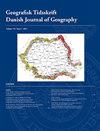How green was my valley: forest canopy density in relation to topography and anthropogenic effects in Manipur valley, India
IF 1.1
4区 社会学
Q4 ENVIRONMENTAL STUDIES
Geografisk Tidsskrift-Danish Journal of Geography
Pub Date : 2018-07-03
DOI:10.1080/00167223.2018.1495090
引用次数: 8
Abstract
ABSTRACT Forest canopy density (FCD) is a major factor in the evaluation of forest status and is an important indicator of possible management interventions. The study uses the FCD model with Landsat TM and Landsat 8 OLI images to assess canopy density in India’s Manipur valley and surrounding hills. Normalized difference built-up index (NDBI) was used to extract built-up areas and population density was retrieved from LandScan data, while elevation and slope were obtained from ASTER DEMs (30 m). Four types of canopy density were delineated with crown cover above 71%, 41–70%, 11–40%, below 10% and areas with no canopy cover, that is 0%. A sharp decline in forest area occurred during 1989–2016 at a rate of loss of 2.9 % year-1 with an average rate of deforestation of 3051 ha year-1. Dense forests exhibited remarkable degradation, especially towards the central valley. The variation in the topographical (elevation and slope) gradient resulted in significant differences in the canopy density over the study area barring some hill slopes. Population pressure and various developmental activities in recent decades led to forest degradation in this fragile yet rich Eastern Himalaya biodiversity hotspot.我的山谷有多绿:印度曼尼普尔山谷森林冠层密度与地形和人为影响的关系
森林冠层密度(Forest canopy density, FCD)是评价森林状况的一个重要因素,也是确定森林管理干预措施的重要指标。该研究使用FCD模型与Landsat TM和Landsat 8 OLI图像来评估印度曼尼普尔山谷和周围山丘的冠层密度。利用归一化差异建成区指数(NDBI)提取建成区,利用LandScan数据提取人口密度,利用ASTER dem (30 m)获取高程和坡度,划分出冠层盖度在71%以上、41% ~ 70%、11% ~ 40%、10%以下和无冠层盖度为0%的4种冠层密度类型。1989-2016年期间,森林面积急剧减少,年损失率为2.9%,年平均毁林率为3051公顷。茂密的森林呈现出明显的退化,特别是向中央山谷方向。地形(高程和坡度)梯度的变化导致研究区除部分山坡外冠层密度存在显著差异。近几十年来,人口压力和各种发展活动导致这一脆弱但丰富的东喜马拉雅生物多样性热点地区的森林退化。
本文章由计算机程序翻译,如有差异,请以英文原文为准。
求助全文
约1分钟内获得全文
求助全文
来源期刊
CiteScore
5.20
自引率
0.00%
发文量
5
期刊介绍:
DJG is an interdisciplinary, international journal that publishes peer reviewed research articles on all aspects of geography. Coverage includes such topics as human geography, physical geography, human-environment interactions, Earth Observation, and Geographical Information Science. DJG also welcomes articles which address geographical perspectives of e.g. environmental studies, development studies, planning, landscape ecology and sustainability science. In addition to full-length papers, DJG publishes research notes. The journal has two annual issues. Authors from all parts of the world working within geography or related fields are invited to publish their research in the journal.

 求助内容:
求助内容: 应助结果提醒方式:
应助结果提醒方式:


